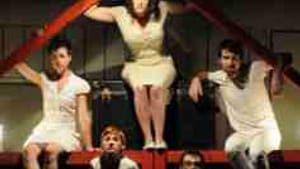Stay in the Loop
BSR publishes on a weekly schedule, with an email newsletter every Wednesday and Thursday morning. There’s no paywall, and subscribing is always free.
Minding everyone else's business
Applied Mechanics' "Overseers' at Fringe Festival

Many Fringe Festival artists fancy themselves game-changing revolutionaries. But few warp the nature of a viewer's aesthetic experience quite as radically as Applied Mechanics.
This group builds each of its pieces on two seemingly contradictory methods. The company intentionally draws its texts from a number of sources related thematically to the overall idea for a piece.
This approach recognizes that we draw the bulk of our beliefs from others— whether we're quoting pop culture or passages from books in lieu of original insights. Applied Mechanics doesn't employ this tactic in a negative sense; instead, the group uses common ideas and familiar passages to anchor and reflect a piece within an audience's experience.
Each of its pieces also discards a traditional proscenium approach to staging a narrative. Instead, characters inhabit part of the space; audience members pick and follow one or more characters and attempt to piece together the whole from its fragments. This strategy fractures the story even as it gives the audience a sense of choice as to which story line to pursue.
Permits for everyone
The group's current piece, Overseers, concerns a revolt in totalitarian Sector K, a polis greeted each day by the reminder of a past cataclysm ("It has not rained in 20,400 hours"). In this well-ordered world, all social bonds consist of minding everyone else's business.
The usual suspects carve out their spheres of influence: A scientist (Mary Tuomanen) warns against contagion, a priest (Kristen Bailey) sneers down from stilts to shore up moral decay; and a bureaucrat (John Jarboe) insists that everyone secure daily permits— for identity, preaching and any (other) form of expression (or existence).
Within the play, the audience follows multiple days in the life of Sector K, experiencing the citizens' traditions (like a "Potensday" party) and concerns: the diminishment of reverence to the state religion, the impossibility of spontaneity in a world of rules, and the ever-present threat of Rappucine's disease— an infection characterized by euphoria and joy. Continual references to the "Body Official" reign over the state as both actual Lord and metaphor for order and one's place in society.
When a refugee (Jessica Hurley) arrives from Sector L, she struggles to assimilate and finds a kindred spirit in Tristan (Thomas Choinacky), a hedonist who flirts with the boundaries of acceptable behavior. Her lack of conformity sparks a romance with a desk jockey (Jarboe). Rebellion follows, in the form of sex, explosives and joy.
Invasive medical tests
Lines of dialogue spring forth from etiquette guides, scientific manuals, the economist Ludwig von Mises, Emily Dickinson, Tom Stoppard and Don DeLillo (perhaps the only writer on the list to have written more about totalitarianism than Stoppard). Throughout, the audience wanders about the cavernous expanse of the Machine Shop's loft.
Some in the audience clearly wonder whom to follow; others dart about trying to catch every scene (impossible). The performers treat patrons as fellow citizens, interacting and conversing, even subjecting us to the invasive medical and psychological tests they inflict on one another.
In its past pieces, Applied Mechanics ameliorated the confusion and loss of textual overlap by running through the entire piece twice (a strategy that New Paradise Laboratories borrowed in its 2009 Fringe hit, Fatebook). These multiple run-throughs gave audience members a chance to follow multiple characters in successive iterations of the same script.
But Applied Mechanics abandons this device in Overseers, running the entire 90-minute piece once. Consequently, the piece reflects on the company's own method while provocatively revealing its virtues.
Stay awake, stay quiet
In traditional theater, the proscenium imposes a boundary. The audience sees what the director-as-overseer intends, and while patrons can avert their gaze or shift their focus, those who do watch all see the same play. Like the characters in Sector K, each audience member minds all the others to stay silent and awake and to pay respect to the work transpiring on stage.
Applied Mechanics' aesthetic liberates us from this tyranny. But instead of disabling art's ability to connect and communicate, the collective's use of well-known texts re-establishes a common ground for shared experience.
Art should offer both a personal and collective experience. Patrons who walk through a museum linger only on those works that speak to them. Each painting acts as a shared object that binds disparate reactions.
Through its radical refashioning of audience experience, Applied Mechanics achieves the same effect with theater. Their approach returns art to the simple, intense joys of discovery and participation in unique, elevated events.
The audience— perhaps exhausted from running around after characters— breathed a collective exhilaration at the play's close. Cheers rang out from glee-filled faces. Like children holding hands in a snowstorm, each audience member could take comfort in a shared experience and yet still treasure the unique snowflake that had touched no other tongue but one's own.
This group builds each of its pieces on two seemingly contradictory methods. The company intentionally draws its texts from a number of sources related thematically to the overall idea for a piece.
This approach recognizes that we draw the bulk of our beliefs from others— whether we're quoting pop culture or passages from books in lieu of original insights. Applied Mechanics doesn't employ this tactic in a negative sense; instead, the group uses common ideas and familiar passages to anchor and reflect a piece within an audience's experience.
Each of its pieces also discards a traditional proscenium approach to staging a narrative. Instead, characters inhabit part of the space; audience members pick and follow one or more characters and attempt to piece together the whole from its fragments. This strategy fractures the story even as it gives the audience a sense of choice as to which story line to pursue.
Permits for everyone
The group's current piece, Overseers, concerns a revolt in totalitarian Sector K, a polis greeted each day by the reminder of a past cataclysm ("It has not rained in 20,400 hours"). In this well-ordered world, all social bonds consist of minding everyone else's business.
The usual suspects carve out their spheres of influence: A scientist (Mary Tuomanen) warns against contagion, a priest (Kristen Bailey) sneers down from stilts to shore up moral decay; and a bureaucrat (John Jarboe) insists that everyone secure daily permits— for identity, preaching and any (other) form of expression (or existence).
Within the play, the audience follows multiple days in the life of Sector K, experiencing the citizens' traditions (like a "Potensday" party) and concerns: the diminishment of reverence to the state religion, the impossibility of spontaneity in a world of rules, and the ever-present threat of Rappucine's disease— an infection characterized by euphoria and joy. Continual references to the "Body Official" reign over the state as both actual Lord and metaphor for order and one's place in society.
When a refugee (Jessica Hurley) arrives from Sector L, she struggles to assimilate and finds a kindred spirit in Tristan (Thomas Choinacky), a hedonist who flirts with the boundaries of acceptable behavior. Her lack of conformity sparks a romance with a desk jockey (Jarboe). Rebellion follows, in the form of sex, explosives and joy.
Invasive medical tests
Lines of dialogue spring forth from etiquette guides, scientific manuals, the economist Ludwig von Mises, Emily Dickinson, Tom Stoppard and Don DeLillo (perhaps the only writer on the list to have written more about totalitarianism than Stoppard). Throughout, the audience wanders about the cavernous expanse of the Machine Shop's loft.
Some in the audience clearly wonder whom to follow; others dart about trying to catch every scene (impossible). The performers treat patrons as fellow citizens, interacting and conversing, even subjecting us to the invasive medical and psychological tests they inflict on one another.
In its past pieces, Applied Mechanics ameliorated the confusion and loss of textual overlap by running through the entire piece twice (a strategy that New Paradise Laboratories borrowed in its 2009 Fringe hit, Fatebook). These multiple run-throughs gave audience members a chance to follow multiple characters in successive iterations of the same script.
But Applied Mechanics abandons this device in Overseers, running the entire 90-minute piece once. Consequently, the piece reflects on the company's own method while provocatively revealing its virtues.
Stay awake, stay quiet
In traditional theater, the proscenium imposes a boundary. The audience sees what the director-as-overseer intends, and while patrons can avert their gaze or shift their focus, those who do watch all see the same play. Like the characters in Sector K, each audience member minds all the others to stay silent and awake and to pay respect to the work transpiring on stage.
Applied Mechanics' aesthetic liberates us from this tyranny. But instead of disabling art's ability to connect and communicate, the collective's use of well-known texts re-establishes a common ground for shared experience.
Art should offer both a personal and collective experience. Patrons who walk through a museum linger only on those works that speak to them. Each painting acts as a shared object that binds disparate reactions.
Through its radical refashioning of audience experience, Applied Mechanics achieves the same effect with theater. Their approach returns art to the simple, intense joys of discovery and participation in unique, elevated events.
The audience— perhaps exhausted from running around after characters— breathed a collective exhilaration at the play's close. Cheers rang out from glee-filled faces. Like children holding hands in a snowstorm, each audience member could take comfort in a shared experience and yet still treasure the unique snowflake that had touched no other tongue but one's own.
What, When, Where
Overseers. Created and performed by Applied Mechanics; directed by Rebecca Wright; designed by Maria Shaplin. Live Arts/Fringe Festival production through September 14, 2011 at the Machine Shop, 2037 Washington Ave. (215) 413-1318 or ticketing.theatrealliance.org.
Sign up for our newsletter
All of the week's new articles, all in one place. Sign up for the free weekly BSR newsletters, and don't miss a conversation.

 Jim Rutter
Jim Rutter